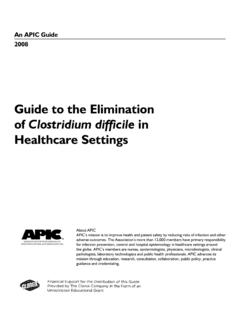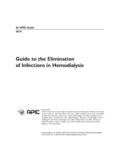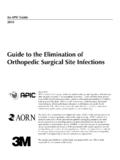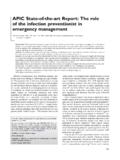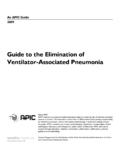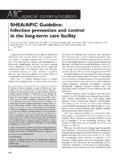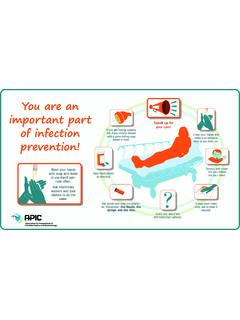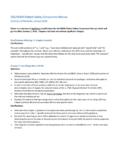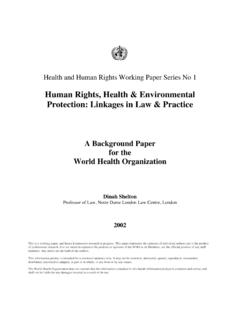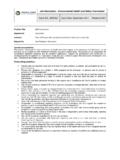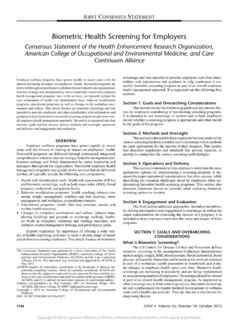Transcription of US GOVERNMENT HEALTH AGENCIES - APIC
1 OUTLINE OF US HEALTH AGENCIES With Functions Related to Infection Prevention and Control I. Department of HEALTH and Human Services (HHS) -- Cabinet-Level Department which includes the following AGENCIES : A. Centers for Disease Control and Prevention (CDC) 1. National Institute for Occupational Safety and HEALTH (NIOSH) 2. Coordinating Center for Infectious Diseases (CCID) a. National Center for Preparedness, Detection, and Control of Infectious Diseases (NCPDCID) i. Division of Healthcare Quality Promotion (DHQP) 3. Healthcare Infection Control Practices Advisory Committee (HICPAC) B. Centers for Medicare and Medicaid Services (CMS) C. National Institutes of HEALTH (NIH) 1. The National Institute of Allergy and Infectious Diseases (NIAID) 2.
2 National Library of Medicine (NLM) D. Food and Drug Administration (FDA) E. HEALTH Resources and Services Administration (HRSA) F. Agency for Healthcare Research and Quality (AHRQ) II. Department of Labor (DOL) -- Cabinet-Level Department which includes: A. Occupational Safety and HEALTH Administration (OSHA) III. Environmental Protection Agency (EPA) Cabinet-Level agency IV. Non-Governmental AGENCIES A. Joint Commission B. Institute of Medicine (IOM) 9/26/08 Page 1 Glossary of Acronyms AHRQ: Agency for Healthcare Research and Quality; part of HHS. CCID: Coordinating Center for Infectious Diseases; part of CDC. CDC: Centers for Disease Control and Prevention; part of HHS. CMS: Centers for Medicare and Medicaid Services; part of HHS.
3 DHQP: Division of Healthcare Quality Promotion; part of NCPDCID under CDC. DOL: US Department of Labor; Cabinet-level agency charged with protection of the American workforce. EPA: US Environmental Protection Agency; Cabinet-level agency charged with protection of the environment. FDA: Food and Drug Administration; part of HHS. HHS: US Department of HEALTH and Human Services; Cabinet-level primary HEALTH agency in the US. HICPAC: Healthcare Infection Control Practices Advisory Committee; part of CDC. HRSA: HEALTH Resources and Services Administration; part of HHS. IOM: Institute of Medicine; non-governmental agency. NCPDCID: National Center for preparedness, Detection, and Control of Infectious diseases; part of CCID under CDC.
4 NIAID: National Institute of Allergy and Infectious Diseases; part of NIH. NIH: National Institutes of HEALTH ; part of HHS. NIOSH: National Institute for Occupational Safety and HEALTH ; part of CDC. NLM: National Library of Medicine; part of NIH. OSHA: Occupational Safety and HEALTH Administration; part of DOL. Sources: US Department of HEALTH and Human Services website ( ) Centers for Disease Control and Prevention website ( ) Centers for Medicare and Medicaid Services website ( ) National Institutes of HEALTH website ( ) Food and Drug Administration website ( ) HEALTH Resources and Services Administration website ( ) Agency for Healthcare Research and Quality website ( ) Occupational Safety and HEALTH Administration website ( ) US Environmental Protection Agency website ( ) The Joint Commission website ( ) Institute of Medicine website ( ) 9/26/08 Page 2 US GOVERNMENT HEALTH AGENCIES US DEPARTMENT OF HEALTH AND HUMAN SERVICES (HHS) Centers for Disease Control and Prevention (CDC) ( )
5 Based in Atlanta, Georgia, the CDC s mission is to promote HEALTH and quality of life by preventing and controlling disease, injury, and disability. CDC seeks to accomplish its mission by working with partners throughout the nation and the world to monitor HEALTH , detect and investigate HEALTH problems, conduct research to enhance prevention, develop and advocate sound public HEALTH policies, implement prevention strategies, promote healthy behaviors, foster safe and healthful environments, provide leadership and training. Those functions are the backbone of CDC s mission. Each of CDC s component organizations undertakes these activities in conducting its specific programs. The steps needed to accomplish this mission are also based on scientific excellence, requiring well-trained public HEALTH practitioners and leaders dedicated to high standards of quality and ethical practice.
6 Within CDC are five Coordinating Centers, the National Institute for Occupational Safety and HEALTH , and Office of the Director The National Institute for Occupational Safety and HEALTH (NIOSH) ensures safety and HEALTH for all people in the workplace through research and prevention. Of the Coordinating Centers, the one most closely related to apic s work is the Coordinating Center for Infectious Diseases (CCID). Within CCID, the National Center for Preparedness, Detection, and Control of Infectious Diseases (NCPDCID) protects populations domestically and internationally through leadership, partnerships, epidemiologic and laboratory studies, and the use of quality systems, standards, and practices.
7 NCPDCID collaborates with the Coordinating Center for Infectious Diseases (CCID), CDC, and the agency s national and global partners to conduct, coordinate, and support infectious disease surveillance, research, and prevention. Each of the center s six divisions complements this cross-cutting mission, working with internal and external partners to improve public HEALTH . apic works most closely with the Division of Healthcare Quality Promotion (DHQP), to protect patients, protect healthcare personnel, and promote safety, quality, and value in the healthcare delivery system by providing national leadership for nine key areas. Healthcare outcomes, Outbreaks in healthcare settings, 9/26/08 Page 3 Emerging antimicrobial-resistant infections, Efficacy of new interventions for patient safety, Clinical microbiology laboratory quality, Water quality in healthcare settings, Cost effectiveness of prevention interventions, Promotion of implementation and evaluation of prevention interventions, and Development of infection control guidelines and policies.
8 DHQP is organized into three main components: the Epidemiology and Laboratory Branch, the Prevention and Evaluation Branch, and the Healthcare Outcomes Branch. The Epidemiology and Laboratory Branch (ELB) provides epidemiologic and laboratory assistance when investigating outbreaks of disease and other adverse events that occur in healthcare settings. ELB is a reference laboratory for hospitals and other healthcare facilities for the identification of staphylococci and their toxins, anaerobic bacteria, and enteric bacteria. ELB confirms and characterizes unusual antimicrobial resistance patterns and delineates the mechanism of resistance. ELB s environmental microbiology team is developing optimum methods to detect and decontaminate healthcare surfaces and water that may be contaminated with Category A and B bacterial agents in a bioterrorism event.
9 The epidemiology section responds to outbreaks of new or emerging infectious diseases and other adverse outcomes associated with the delivery of healthcare. Examples of such responses include the first-ever description of rabies transmission associated with organ transplantation, investigation of nationwide outbreaks associated with contaminated medications and devices, investigation of a nationwide epidemic of Clostridium difficile-associated disease, and responding to the emergence of methicillin-resistant Staphylococcus aureus (MRSA) outside healthcare facilities, including increasing rates of MRSA skin and soft tissue disease. The Prevention and Evaluation Branch (PEB) develops and promotes the implementation of evidence-based guidelines, recommendations, and other interventions to prevent healthcare-associated infections and antimicrobial resistance, related adverse events, and medical errors; evaluates the effectiveness of novel and proven interventions for prevention of healthcare-associated infections and antimicrobial resistance, related adverse events, and medical errors; and develops, disseminates, and evaluates training and other HEALTH communications tools designed to protect patients and healthcare personnel and to promote quality healthcare.
10 The Healthcare Outcomes Branch (HOB) conducts surveillance, research, and demonstration projects to measure the impact of healthcare-associated infections, adverse drug events, and other complications of healthcare. HOB staff work closely with healthcare practitioners and healthcare facilities and with partners in other federal AGENCIES , accrediting bodies, and professional groups. A major initiative currently underway in HOB is the launch of the National Healthcare Safety Network (NHSN), a web-based system for monitoring healthcare-associated adverse events. More than 300 U. S. hospitals are enrolled; many more are expected to participate when NHSN is fully operational. Also under the jurisdiction of CDC is the Healthcare Infection Control Practices Advisory Committee (HICPAC).
